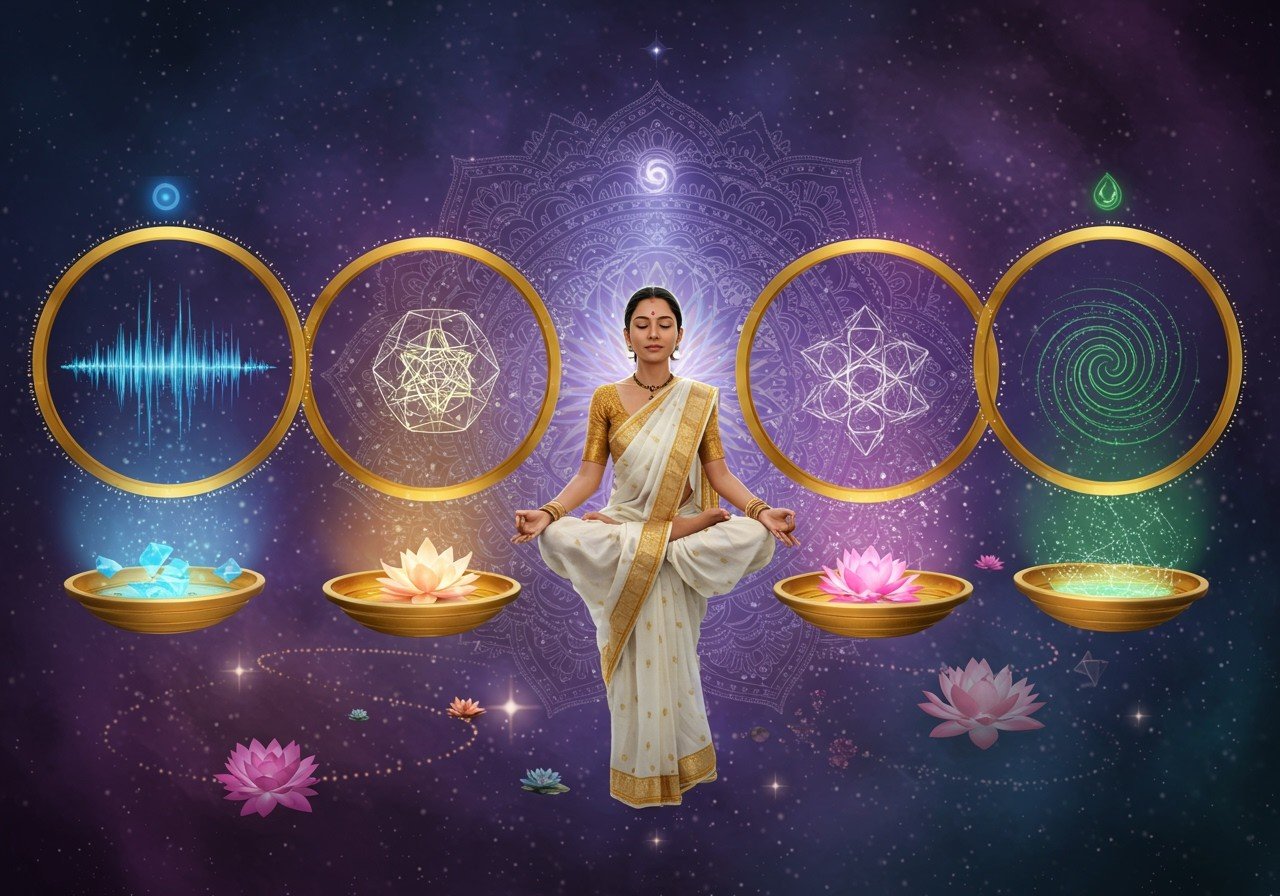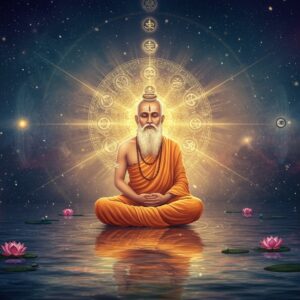Delving into the Tanmatras: The Subtle Elements of Hindu Philosophy

In Hindu philosophy, the concept of Tanmatras is profound and intriguing. Derived from the Sanskrit words ‘tat’ (that) and ‘matra’ (measure), Tanmatras are subtle elements that form the foundation of sensory perception. They bridge the tangible and intangible, linking the physical world with deeper spiritual understanding. For those who hold tradition dear, exploring Tanmatras offers insight into ancient wisdom and its relevance today.
Understanding the Significance of Tanmatras
Tanmatras play a vital role in Samkhya and Vedanta philosophies. These subtle qualities are considered the root of sensory perception. They precede the Pancha Mahabhutas, or the five great elements. The five Tanmatras connect to the human senses: sound (shabda), touch (sparsha), form (rupa), taste (rasa), and smell (gandha). Each one shapes how we perceive reality and holds significance in spiritual practices and rituals. Understanding Tanmatras enhances our connection to traditional Indian spirituality. For a deeper understanding of rituals, explore our articles on Yantras and Yagyas and Online Puja Bookings.
Exploring the Five Tanmatras
Exploring the five Tanmatras unveils a fascinating layer of Hindu philosophy. In Sanskrit, these subtle elements are known as Shabda (शब्द), Sparsha (स्पर्श), Rupa (रूप), Rasa (रस), and Gandha (गंध). They form the basis of how we perceive the world.
Shabda (शब्द) – The Essence of Sound
Shabda, or sound, is the Tanmatra connected to the element of ether (Aakash). It represents the essence of vibration and communication. In Vedic traditions, sound holds a sacred place. Mantras, chants, and hymns are used in rituals to connect with the divine. The ear is the sensory organ for Shabda, capturing the vibrations that influence our consciousness. Consider enhancing your spiritual practice with our premium Lavender Prayer Agarbatti for a truly immersive experience.
Sparsha (स्पर्श) – The Power of Touch
Linked to air (Vayu), Sparsha embodies the sensation of touch. This Tanmatra emphasizes movement and change. In Ayurveda, touch plays a crucial role in therapies like massage and acupuncture. The skin senses Sparsha, absorbing energies that promote healing and balance. It helps us feel connected to our surroundings.
Rupa (रूप) – The Significance of Form
Rupa relates to fire (Agni) and signifies form or shape. Fire transforms and illuminates, symbolizing clarity and vision. In rituals, the use of lamps and flames represents purity and focus. The eyes perceive Rupa, capturing light and color that define our visual experiences. Art and aesthetics draw inspiration from this Tanmatra. Poojn.in offers a selection of camphor tablets ideal for traditional lamps and rituals.
Rasa (रस) – Experiencing Taste
Rasa, associated with water (Jala), is the essence of taste. It brings joy and satisfaction to life. In culinary traditions, Rasa is celebrated through diverse flavors. Water carries Rasa’s essence, quenching thirst and nurturing life. The tongue experiences Rasa, guiding our choices in food and drink. You can elevate your offerings with our Premium Gulab Jal, perfect for adding a touch of purity to your rituals.
Gandha (गंध) – The World of Smell
Gandha ties to earth (Prithvi) and symbolizes smell. It grounds us with its solid, stable nature. Incense and fragrances enhance spiritual practices, invoking serenity and focus. The nose detects Gandha, connecting us to memories and emotions tied to scents. Explore our range of incense sticks to enhance the atmosphere of your sacred space. Discover more about sacred Hindu symbols in our blog post on Rudraksha and Tulsi.
Tanmatras in Daily Life: Enhancing Mindfulness
The Pancha Tanmatras influence our everyday existence. Understanding them can enhance mindfulness and enrich our sensory experiences.
- Shabda: Music therapy uses sound to soothe and uplift the mind, promoting relaxation and inner peace. The rhythmic chanting of mantras, a powerful form of Shabda, helps to focus attention and connect with the divine.
- Sparsha: Physical therapies like massage use touch for relaxation and healing, easing muscle tension and improving circulation. The gentle pressure applied during massage stimulates nerve endings and promotes a sense of well-being.
- Rupa: Art therapy engages the visual senses for emotional expression, allowing individuals to communicate their feelings through creative mediums. The vibrant colors and intricate patterns in traditional art forms can evoke a sense of awe and inspiration.
- Rasa: Nutrition focuses on taste for health and wellness, emphasizing the importance of balanced diets for optimal physical and mental function. The enjoyment of flavors encourages mindful eating and appreciation for the nourishment food provides.
- Gandha: Aromatherapy uses scent for therapeutic benefits, promoting relaxation, reducing stress, and enhancing mood. The fragrant aromas of essential oils can create a calming and peaceful environment, conducive to meditation and spiritual practices.
Embracing these Tanmatras fosters a deeper awareness of how we interact with the world. They remind us of the importance of balance and harmony in life. Delve into the enchanting stories of Lord Krishna, a deity deeply connected to Rasa, in our blog post: Enchanting Tales of Lord Krishna. Find inner peace through meditation and mantras, practices deeply rooted in Shabda, with our guide: Meditation and Mantras.
Poojn.in: Your Guide to Connecting with the Tanmatras
Poojn.in offers a wide range of products that can enhance your connection to the Tanmatras. Our Pancha Sasya, a blend of five sacred grains, connects you with the Earth element (Gandha Tanmatra), representing fertility and abundance. You can find it for just ₹5.
We also offer:
- Gandha (Smell): Pure camphor and natural fragrances for creating a sacred atmosphere.
- Rasa (Taste): Ingredients for preparing sacred food offerings.
- Rupa (Form): Traditional ritual items and vessels such as Sindoor Dibbi.
- Sparsha (Touch): High-quality ritual fabrics and materials.
- Shabda (Sound): Bells and ritual instruments.
All our products are authentically sourced, quality-checked, and competitively priced. Bulk orders and doorstep delivery are available. Contact us at +91 3369029784 for wholesale inquiries. Visit www.poojn.in to explore our complete collection. Read more about traditional Hindu architecture, which embodies the Tanmatras, in our blog posts: Hindu Temple Architecture and Key Elements of Traditional Hindu Architecture.
Embracing the Tanmatras for a Fuller Life
The Tanmatras offer a unique perspective on our connection with the universe. They encourage us to appreciate sound, touch, form, taste, and smell with renewed awareness. By understanding these subtle elements, we honor ancient wisdom while enriching our lives. Each Tanmatra guides us towards balance and harmony, reminding us that our senses are pathways to deeper understanding and fulfillment. Embracing these elements cultivates a life filled with mindfulness, tradition, and joy.
FAQs: Understanding the Tanmatras
What are the Pancha Tanmatras in Hindi? The Pancha Tanmatras are known as रूप (Roop – Form), रस (Ras – Taste), गंध (Gandh – Smell), स्पर्श (Sparsh – Touch), and शब्द (Shabd – Sound).
What is the Sanskrit meaning of Tanmatras? In Sanskrit, Tanmatras represent the five subtle elements: रूप (Roop), रस (Ras), गंध (Gandh), स्पर्श (Sparsh), and शब्द (Shabd).
How do Tanmatras relate to our senses? Each Tanmatra corresponds to a specific sense: Roop to sight, Ras to taste, Gandh to smell, Sparsh to touch, and Shabd to hearing.
What is the importance of Tanmatras in Indian philosophy? Tanmatras are fundamental to understanding perception and how we interact with the world through our senses.
How do Tanmatras connect to the physical elements? They serve as the subtle basis for the Pancha Mahabhutas (five great elements): Earth, Water, Fire, Air, and Space. Learn more about these connections in our post: Hindu Architecture Styles.
Can we directly experience Tanmatras? Tanmatras are subtle and not directly perceivable; we experience them through their manifestation in the physical elements and our senses.
What role do Tanmatras play in meditation? Focusing on Tanmatras during meditation deepens awareness of the subtle aspects of existence, fostering spiritual growth. This ties in beautifully with our post on Hindu Architecture: Tradition Meets Modern Design , exploring the serene spaces conducive to such practices.
Are Tanmatras associated with specific deities? While not directly linked to deities, they are often associated with the deities governing the senses and elements in various spiritual traditions. Explore the divine feminine at the Hatimura Durga Temple with our blog post: Hatimura Durga Temple. Plan your visit for Maha Shivaratri with our guide: Maha Shivaratri 2025 Dates and Events.


